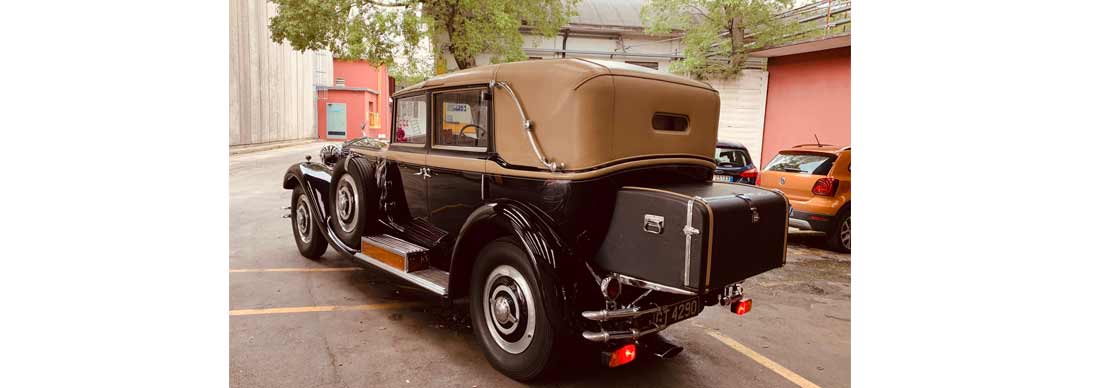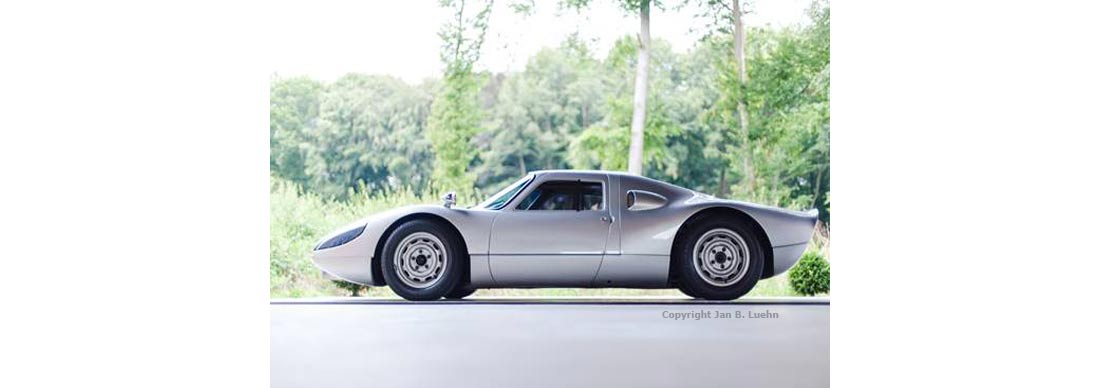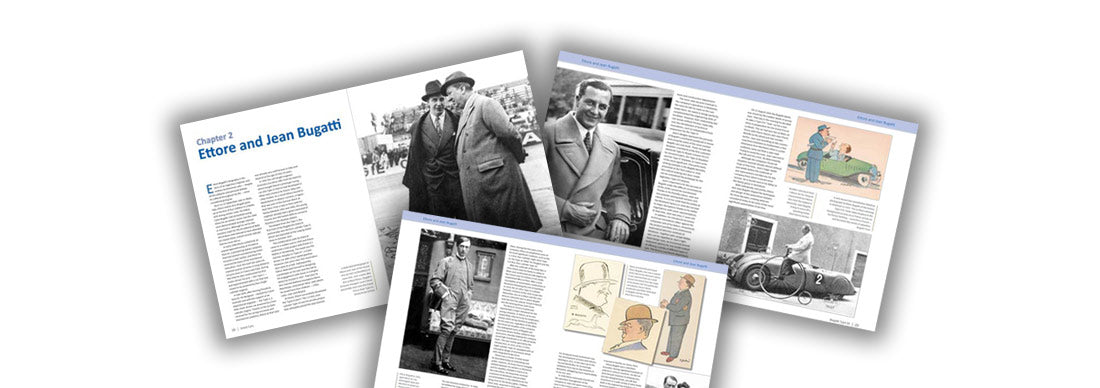
The Swansong of the Great
Above image: The Isotta Fraschini Tipo 8B Landaulette-de-Ville Imperial, by Castagna, in all its beauty.
1931 Isotta Fraschini Tipo 8B Landaulette-de-Ville Imperial by Castagna, chassis #1714 The original Milano, New York and London Motor Show car
Today, I finally have permission to talk about this fabulous SuperFind.
Initially, I had to promise not to talk about it at all. Thankfully, the time has come to tell the story of one of the greatest cars ever. It’s a real connoisseur’s story and I hope you will enjoy it. There is a lot of British history involved.
Some time ago, I was kindly invited to Italy to give my humble opinion about a classic-car collection.
Briefed beforehand by a middle man on the phone, I was told in no uncertain terms that I was not to be rude, inquisitive, or (even worse) make any stupid remarks about money. What I was going to see was a secret. He couldn’t tell me anything about the cars, but appeared rather nervous. Nothing was for sale, and this seemed very important to him. Humbly, I agreed and promised to be a good boy, wondering what all this was about.
I met that man as agreed, near the motorway, and did my best to follow him in my little 1974 Porsche 911 Coupé, when suddenly we exited into an old factory complex. That was the hiding place.
After being introduced to the nice owner and his lovely family, and after some grilling over a cup of espresso, I was cleared to see the treasures. It was now obvious the cars had been handed down from one generation to the next, and the initial caretaker was long gone. Some knowledge of the cars must have been lost along the way, and I was asked to do the best I could to provide my historical and technical insight.
I was also asked to give an opinion about the future of the collection. Of course, I felt very honoured about all this and set to work immediately. The family followed me to the cars.
Upon entering a rather dark, unused factory complex, I saw many dusty cars hidden away in the corners, which had clearly been sitting there for years or even generations. Some of them were of fine pedigree, others just the usual early Fiats.
A big 1931 Isotta Fraschini Tipo 8B caught my eye right away. And yes, you are reading it correctly, Tipo 8B, not a Tipo 8A.
I can assure you that not many people have ever seen one before. Cars of this calibre rarely come out into the open, and the Tipo 8B is akin to a Crown Jewel of automotive heritage – as rare as a good Rembrandt portrait, a Van Gogh landscape or a Breughel winter scene.
The Tipo 8B was flanked by a totally original Tipo 8A Sedanca and an assortment of Alfas and Lancias. One particularly fine 6C Alfa Romeo 1750, with body by Gangloff (Zurich), also caught my eye (but that’s another story). I knew from my earlier experience with Isotta Fraschini that there were only a handful of 8Bs made from 1931 onwards. The luxury car company got caught out by the big Wall Street crash in 1929 and had to stop production of this hugely expensive model. Many orders were cancelled.
It’s still unknown how many Tipo 8Bs were built, and to my knowledge only two survive, but I would be very happy to be told otherwise. Please let me know! The only other one I might have seen was with Arturo Keller in the US, but none is so important as this one. It was the best Isotta I had ever seen, and it had some British roots too.
This Tipo 8B was the star of the 1931 Salone dell’Automobile di Milano in April and was then shipped to New York for the Auto Show there shortly afterwards. According to a testimony by Carlo Castagna it was destined for press magnate William Hearst, already the owner of a Tipo 8A with body by Castagna. However, Castagna recalls that the deal was not concluded and the car was sent back to Europe. A new, solvent client had to be found immediately.
With the help of the famous Isotta Fraschini importer Anthony Lago, the car apparently was a last-minute exhibit at the London Olympia Motor Show in 1931. The grand car was very well received, and was bought by a trusted client of Anthony Lago, a Mrs. Vera Twyford of Lowndes Square, London, and first registered on 1 September 1931. It was the third Isotta Fraschini owned by the Twyfords, the previous ones having been bought in 1927 and 1929. They didn’t use the car much, and it survived Word War II unscathed in one of their country houses. If there is any link between the Twyford family and the American Twyford car company I could not find one, but it’s possible.
In 1956, the car was given to noted collector Beverly Brierley and he kept it until 1961, when the engine block became frost damaged.
In 1985, after long negotiations, the car was purchased by the present owners, who found a brand-new engine, and returned the car to the road in Italy. Some work was apparently done by Maitre Lecocq in Paris. The original engine is still sitting next to the car and I can tell you it’s quite a sight – a huge sculpture in fact, like a work of art.
The Isotta Fraschini Tipo 8B is very luxuriously appointed as a unique Landaulette-de-Ville Imperial (an old style of the vintage era) and features very precious fabrics and trimmings, occasional seats in the rear, original scent and perfume bottles, cigar lighters, and a unique electric signalling system to the chauffeur. There are blinds in the windows and courtesy lights to the running boards. The interior is palatial, much in the fashion of a good Rolls-Royce Phantom or a grand Bentley 8-litre limousine, but even more luxurious and more refined, with Italian style and elegance. It has full Grebel lighting all around. An Isotta Fraschini was simply the epitome of luxury in the days of the grand Hollywood stars and international high-society. As much as I love Rolls-Royce Phantoms, or big Bentleys and grand Bugattis, they clearly came second to the Isotta Fraschini. A Bugatti Royale is austere in comparison.
Today, this Landaulette Imperial has covered a minuscule mileage – around 19,000 miles or so – and the car is in truly outstanding original condition. The aura is majestic, and it gives you the shivers when you first enter the cockpit. Intimidating might be a better word to describe it – you are literally embraced by history.
Viewing the car, I summoned up my courage and asked politely if I could carefully start her up to check the condition of the engine. That’s what I was there for, wasn’t it? Apparently, nobody had driven the car for quite a while, so they had a long talk and decided to let me carry on. I checked the fuel and water, and looked into the oil filler to check for water ingress or other indications of oil mixing with water. All appeared good.

Above: Seven fine dials are the window to the mechanical soul of the Isotta.
I removed the large cam cover and poured a litre of fresh engine oil over the top of the valve gear and the cylinder head. The engine is more than a metre high, and it would take at least three minutes for the oil pump to pump the oil up to the valve gallery when starting from cold – too long to avoid the risk of wear and tear.
With the help of an external battery, I turned the engine over for a minute (with the ignition disconnected) to bring up the oil pressure. When I smelled the petrol coming, I adjusted the starting carburettor and gave it a try. Ignition to ‘late’ and mixture to ‘rich’ and the engine started immediately, slowly but surely increasing the revs to 500rpm on idle. What a magnificent rumble!
A sound deeper and more purposeful than a Phantom II or a 6-cylinder Bentley, more like a big Hispano. Harsh and a bit rough, but at the same time very eager to rev. I could feel the power of the 7.3-litre behemoth and recognised it immediately as a thoroughbred engine. (Whereas, the Tipo 8A has a more like truck-like and heavy old engine.)

Above: The majestic 7.3-litre engine produces around 150HP at 3,000rpm, but it’s all about torque of course.
After a long warming-up phase, the needles came alive and the fine, black-faced instruments started talking to me. I was checking the water flow and radiator shutters, and it was all very satisfactory. Ready to go. Everybody got inside and we went for a drive. The spindly art-deco instrument needles were moving eagerly into their correct spots.
It was a truly majestic ride. The engine willing, the cold gearbox willing to change gear progressively, and then the most astonishing thing in the world: would you believe, almost featherlight steering. I mean, this is a three-ton car!

Above: The Landaulette-de-Ville bodywork, by Castagna, in its various configurations.
What a magnificent vehicle this must have been in the day. I had to manage quite a few ugly corners around that factory complex but, boy, it felt just perfect. I could have gone on forever, directly to Paris parking in front of the Ritz Hotel, were it not for the lack of fuel in the tank. And, from the smell I would say that the fuel must have been at least 5 years old.
Anyway, I thought, warming her through and keeping her running for a bit was important for the car. The fine tick-over provided a well-orchestrated concerto of valves and helical gears. I found the engine very good indeed. No smoke, and I could see no fluids leaking out from underneath the car. Pure perfection!

Above: The Tipo 8B at the stand of the 1931 Salone dell’Automobile di Milano.
The owner seemed happy, and I finally understood what that marvellous Isotta Fraschini Tipo 8B legend was all about. I complimented the family on their great automobile treasure, and could see real passion in their eyes.
Technical points
The Tipo 8B included a great many improvements over the Tipo 8A. It had an all-new 7,300cc in-line eight, with 5:1 compression. The block was now a nickel-steel casting, and the pistons and connecting rods were of the same material. The valve gear was very light, and there were now two completely separate exhaust manifolds, as in a race car. The crank was stiffer and heavier, and had nine(!) main bearings, revving easily to 3,000rpm. A new Bosch coil-ignition system replaced the magneto, and the four-speed gearbox was a synchromesh type with helical gears. The chassis was stronger and stiffer, with deeper side members and two extra crossmembers. The power output was rated the same as the Tipo 8SS (about 150HP), and there was enough power to catapult any chassis to around 90–100mph, depending on road conditions.

Above: A lovely period shot from the 1950s.
Sadly, this sophisticated model was the swansong of Isotta Fraschini. Trading conditions were difficult, not only because of the Wall Street crash, but also due to increased competition from the new V12 Hispano-Suiza, the improved Rolls-Royce Phantom II, the Mercedes 770 and the Bugatti Type 41 Royale.
In 1933, Isotta Fraschini car production began to run down, and the last chassis were built about two years later, in 1935. Very few Tipo 8Bs were made at all. After 1935, only maritime engines and commercial diesels were constructed, first for the Italo-Ethiopian War and then World War II. Some of the unsold chassis became ambulances.

Above: Getting to terms with the behemoth for its first run after years.
This Tipo 8B allowed me to journey into another world, the very significant and unique car culture of Italy. Designers and technical staff who learned their craft with Isotta Fraschini sparked the great racing designs of Maserati and Ferrari. Isotta is a story of real automotive treasure, passion and genius.

Above: A majestic sculpture on wheels. Pure elegance!
Export ban
There is one more twist to the tale. For some reason (and I never fully understood why) this once British-registered Isotta Fraschini is not allowed to leave Italy. The authorities have put an export ban on the car. I would have loved to show it in UK, but it is not allowed to leave the country even for an exhibition or a Concours d‘Elegance. It’s actually the first car I have ever encountered in its very own lock down! Maybe someone can help to solve this Italian export-ban mystery? It applies to many significant cars in Italy, and prohibits exposure and sales. Any experience in this matter would be much appreciated.






2 comments
Dear Iván,
Thank you for your interesting comment regarding India’s historic cars. Unfortunately we do not have any additional images of this Isotta.
Thank you,
Wayne
Porter Press
India has had similar export bans on historic vehicles since the 1970s. Unfortunately, many car treasures were smuggled out of the country. Do you have more pictures of this magnificent Isotta in PM?
Iván Balázs
Leave a comment
This site is protected by hCaptcha and the hCaptcha Privacy Policy and Terms of Service apply.